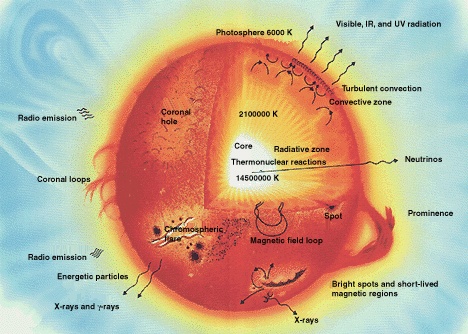For Shakespeare: How Hot Is the Sun?
>> Sunday, July 18, 2010

Shakespeare asked: How hot is the sun, how did it get this way, and how does it stay hot without burning up?
Good questions. First off, whenever I get a question about the solar system, I stop off first at Nineplanets.org. Great educational stuff about about the planets, their moons and, of course, the sun. Wikipedia's a good source, too. The temperature of the Sun is actually a tricky question. Like the gas giants, the sun isn't a solid mass but a tightly packed gaseous mass (though it is very very massive - 99.8% of the solar system mass is contained within it's "boundaries).
At the core, where the heat is generated, the temperature is 15.6 million degrees Kelvin (and about the same Centigrade - when you get that hot the 270 odd degree difference in scale really doesn't matter). I can't think of an analogy to tell you how hot that is, but it's hotter than anything we can make (or at least sustain) here on earth. The core is also under so much pressure (from the gravitational weight of all that mass) that the core of superheated hydrogen gas is actually 150 times denser than water. Think of that, gasses that weigh more than water.
Near the boundary's of the sun, the so called "surface of the sun" the heat and pressure are much less, 5800 degrees Kelvin (which is still unbearably hot) with sunspots that can be 2000 degrees cooler. However, above this level, there is another level, called the corona that extends far out from this solar "surface" and can be hotter than the surface itself, ~1 million degrees K. You can see the corona in this photograph during a solar eclipse.
Solar flares and limbs and also shove out streaks of fire from the surface. Is this a cool picture or what (taken by Hinode's Solar Optical Telescope)? The way we understand things, the sun was formed when a dense molecular cloud of hydrogen collapsed. The weight of the mass caused tremendous pressure and heat in the core triggering a nuclear reaction. The heat and energy from the nuclear reaction keep the fire going. Now, that may not make much sense, so let me explain, step by step.
The way we understand things, the sun was formed when a dense molecular cloud of hydrogen collapsed. The weight of the mass caused tremendous pressure and heat in the core triggering a nuclear reaction. The heat and energy from the nuclear reaction keep the fire going. Now, that may not make much sense, so let me explain, step by step.
If you compress a gas suddenly, you will increase pressure and temperature. Release it, suddenly, the gas will cool and pressure drops. This is adiabatic heating and cooling and it happens from the work done on the gas without any additional heat added from the outside. There was a lot of pressure, a lot of compression and that meant a lot of heat, which is how the reaction was triggered.
Nuclear reactions aren't like burning the way most of us know it. When something is "burned" we are really breaking down the structure of a mass, combining some of it with oxygen (which is required for fire) and sending much of it into the air. The mass of an object if one could capture all the byproducts from combustion, is the same. Matter can't be created or destroyed without nuclear reactions.
For example, if you burn hydrogen gas in an oxygen atmosphere, you'll get water in return. But the hydrogen's still there, as part of the water, H2O. You can extract it back out because it can't be destroyed with simple combustion.
However, with nuclear reactions, elements are changed into other elements, combined or reduced, and the extra mass those elements shed are released as energy, a lot of energy: e=mc^2 which means the mass times the speed of light squared. That's a lot of energy for a little bit of mass. With fission, the extra mass comes from changing a heavy element, like uranium, into something less heavy like Xenon or Barium. However, even more powerful than a nuclear fission reaction is a nuclear fusion reaction, where hydrogen atoms (the smallest, lightest element) combines to form helium atoms (the second smallest lightest element). The extra mass from the two atoms to form the one larger atom is released as heat and radiation. A great deal of both.
That's what heats up the sun.
And, it is burning up its fuel. It just has so much of it that it takes a really really long time. The sun has used up a great deal of its hydrogen and has a great deal of helium from this reaction. In about another five billion years, it will use up all the hydrogen and start causing helium fusion which makes carbon. The sun will expand, out past where our planet is now, until it's used up all the helium, when it will throw off its outside layers and collapse into a little tiny star.
Fortunately, five billion years is quite a bit of time yet, so no nightmares.




That is the coolest answer ever. I'll do my best to explain both this answer and the two-armed one to my son and daughter. I'll let you know if they have further questions.
I learned from our science classes that Scientists believe that the temperature on the surface of the sun is about 6,000 degrees Centigrade.Really hot!But this are just estimation since we almost know nothing about the interior of the sun. Anyways thanks for this very interesting post.